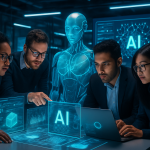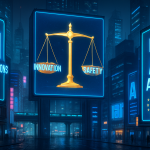Lights flicker, servers hum, and the digital ink is finally dry. After a grueling nearly year-long standoff that felt like a real-life boss battle, SAG-AFTRA and major video game companies have reached an agreement, effectively ending the strike that began back in July 2024. Remember the panic? The speculation? The existential dread that maybe, just maybe, our favorite gruff space marine’s voice would soon be generated entirely by a soulless algorithm?
Well, breathe easy, gamers and actors alike. The future isn’t quite Skynet just yet. But to understand why this agreement is such a big deal, we need to rewind a bit.
Think back to November 2022. The previous labor contract between SAG-AFTRA and the gaming giants expired. Negotiations for a new agreement quickly hit a wall- a digital wall made of ones and zeros, specifically. At the heart of the issue? The rise of artificial intelligence and its potential to, shall we say, “borrow” a bit too much from human performers. We’re talking voices, likenesses, the very essence of what makes a character believable and engaging. The actors rightfully feared being replaced, their voices deepfaked into oblivion, their careers relegated to the digital scrapheap. It’s a valid fear, one that resonates far beyond the gaming world. Imagine Meryl Streep being digitally replicated for a shampoo commercial without her consent. Or Beyoncé’s voice being used to sell insurance. The implications are staggering.
So, SAG-AFTRA members authorized a strike in September 2023, and by July 2024, the digital picket lines were drawn. Production stalled. Games were delayed. The industry held its breath. It wasn’t just about money; it was about control, about ownership, about the very definition of artistry in an age where technology blurs the lines between human and machine.
And now, on July 9, 2025, the dust has settled. The agreement is ratified, and it’s a landmark victory for performers. But what exactly does it entail?
The headline? AI Protections. This isn’t just a vague promise; it’s a concrete set of guidelines and restrictions on how AI can be used to replicate performers. Companies must now obtain explicit consent before creating digital doppelgangers. Think of it as the digital equivalent of signing a release form before appearing on camera. Except, in this case, the camera can record your voice and mannerisms and then use AI to make you say or do anything it wants. Consent is key, and that’s a huge win.
And it’s not just about consent. Compensation and Residuals are also addressed. Performers will be fairly paid for their work, including any AI-generated reproductions. This means that if a company uses an AI to create a digital version of an actor’s voice, that actor will receive royalties every time that voice is used. It’s a fair system, and it ensures that performers are not exploited by technological advancements.
Finally, the agreement also includes Enhanced Working Conditions for voice actors and motion capture artists. This includes safety measures and better overall treatment. After all, even in the digital age, human beings are still the ones bringing these characters to life.
The implications of this agreement are far-reaching. It’s not just about video games; it’s about setting a precedent for the entire entertainment industry. It’s about saying that technology should be used to enhance human creativity, not replace it. It’s about protecting artists’ rights and livelihoods in an age of rapid technological change.
Which companies are most affected? Obviously, the major video game publishers are directly impacted. But the ripple effects will be felt across the board- from Hollywood studios to independent filmmakers to anyone who uses AI to create digital content. This agreement sends a clear message that artists’ rights must be respected, regardless of the technology involved.
But what about the bigger picture? This agreement raises some profound philosophical and ethical questions about the role of AI in society. Are we heading towards a future where human creativity is obsolete? Are we going to be replaced by algorithms and robots? The answer, hopefully, is no. But it’s up to us to ensure that technology is used responsibly and ethically. This agreement is a step in the right direction, but it’s just the beginning.
And let’s not forget the financial implications. This agreement could lead to higher production costs for video games and other digital content. But it could also lead to a more sustainable and ethical industry, one where artists are fairly compensated for their work. In the long run, that’s a good thing for everyone.
Think of it like this: remember the early days of music streaming? Artists were getting pennies on the dollar, and the entire industry was in turmoil. Eventually, things stabilized, and a more equitable system emerged. This agreement is a similar step towards creating a more sustainable and ethical ecosystem for the entertainment industry in the age of AI.
So, what’s next? This agreement is a victory, but the battle is far from over. AI technology is evolving at a breakneck pace, and we need to be vigilant about protecting artists’ rights and ensuring that technology is used for good. But for now, let’s raise a glass (or a health potion) to SAG-AFTRA and the video game companies for reaching an agreement that puts people first. The game is on, and human creativity is still in the lead.
Discover more from Just Buzz
Subscribe to get the latest posts sent to your email.


